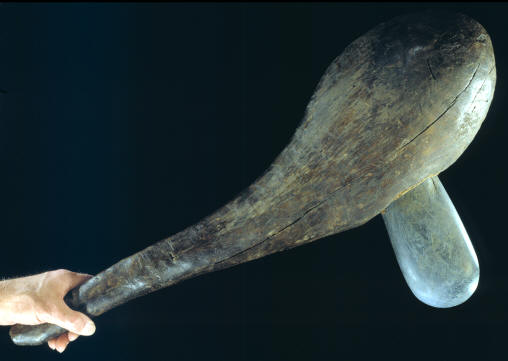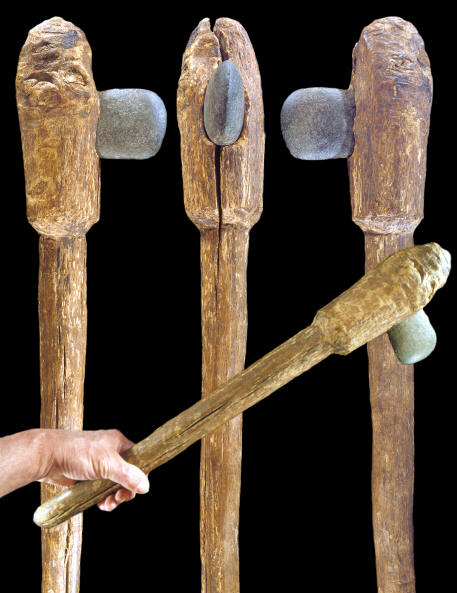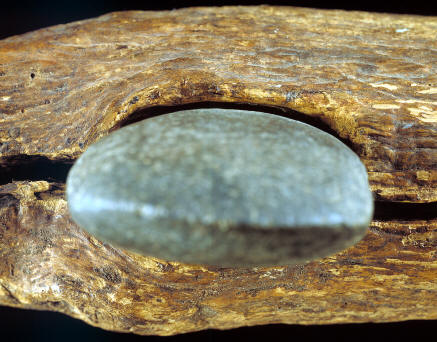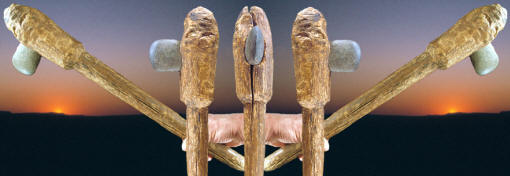|
"It is a type of
rare tool of grand proportions (referring to a
bulbous axe) that is rapidly
disappearing from the Grand Valley (highlands
of Arian Jaya). Daoke Mabel says that
this one is now sacred. In the immediate Jiwika area, Daoke Mabel knows
of only one other of similar size and beauty"---1999,
O. W. Hampton, "Culture Of Stone," p. 149.
"The Dani and others in the western region use
both the Tagime and Yeineri manufactured axes for splitting large felled
trees, sometimes for splitting smaller wood, but almost never for
chopping down trees, for which they simply prefer the adze."------1999,
O. W. Hampton, "Culture Of Stone," p. 59.
"I would hazard a guess that at contact time there was a minimum of
ten adzes per one axe and one to three axes per living compound."---1999,
O. W. Hampton, "Culture Of Stone," p. 60.
"I found no
restrictions against women using axes, but I never observed a woman
using one. Twice I saw a woman using an adze to smooth or sharpen her
digging stick-----."---1999, O. W.
Hampton, "Culture Of Stone," p. 60.
"A large axe blade, with or without the haft, is the most valuable stone
tool that the Dani possess and may be considered an item of wealth."---1999,
O. W. Hampton, "Culture Of Stone," p. 60.
"Celts (ungrooved axes),
in their various patterns, were among the most important implements
known to primitive man."---1912,
Frederick Webb Hodge, Handbook of American Indians North of Mexico,
"Celts," vol. 1, pp. 225-226.

HAFTED UNGROOVED
AXES
EST. 4000 B.C. TO PRESENT
EUROPE, NEW GUINEA &
NORTH AMERICA
Ungrooved axes are found on late Stone Age sites around the world. These
large heavy duty tools were made primarily for chopping wood. Very few
discoveries have been made of early period handles along with their
stone axes. So, in most cases, all that is left for study are the stone
axe heads. The best location for observing and recording the use of
stone axes has been in Arian Jaya and Papua New Guinea. Many of the
tribal groups living there have been using stone axes until very
recently. Archaeologists now have a fairly clear understanding of how
efficient these primitive tools were to use.
|
|

BULBOUS AXE
RECENT
ARIAN JAYA, WESTERN NEW GUINEA
Bulbous type axes are the most impressive stone tools that have been
made in the highlands of Arian Jaya. There are two basic types of
axe handles. The other has is a narrower handle that does not have
the exaggerated bulbous end. In either type, the stone axe may or
may not extend through to the opposite side of the haft. This
example is imbedded into one side only. Axes are rare in New Guinea,
if compared to adzes. Their normal use is for splitting wood.
Hampton writes, "I would hazard a guess that at contact time there
was a minimum of ten adzes per one axe and one to three axes per
living compound." The handle on this example measures 28 1/4 inches
(71.8 cm) long and 7 3/4 inches (19.7 cm) wide. |
|
|
Over the last 150 years or more, ungrooved axes have been
called axes, axe heads, celts, round celts, hatchets, thunderbolts and
thunder axes. The last two terms are the oldest and were used in Europe
by the rural public in the 1800's and earlier. The term celt has been
used in North America, but when a handle is applied the assemblage is
then referred to as an axe. The term celt was first used in Europe
and the name may originate from either the Latin words celtis or celtes
which means "chisel" or from the Welsh word cellt which means "a flint
stone." |
|

CLICK ON
PICTURE FOR LARGE TRIPLE IMAGE
HAFTED CELT
LATE STONE AGE
NEW MEXICO
This axe handle may date to sometime close to
European contact. Little is known about it except that it's
reported to have been found many years ago in a dry rock shelter in
New Mexico. The celt was attached to the handle after it was discovered
and is not original to the handle. The hafting area is split which
would have caused the original owner to discard it. The hafting
socket is actually the base of a limb or knot in the wood. The wood
is weathered and seems to be quite old.
The narrow end of the handle is slightly sharpened and appears to
have once served as a digging tool. No radio carbon date or
identification of the wood has been attempted. The handle measures
24 inches (61 cm) long and 3 inches (7.6 cm) wide. |
|
|
Ungrooved axes are found, in one form or another, on late
Stone Age sites on all continents around the world except Antarctica. In
the archaeological record they have long been recognized, as
Frederick Hodge stated in
1912 that
"Celts (ungrooved axes), in their various patterns, were among the most
important implements known to primitive man." Axes began to be used in
larger numbers as more and more land began to be cleared for
cultivation. John Coles wrote that "The indisputable fact that vast
areas of Europe, North America and Asia were forest-covered when the
first agriculturists penetrated, meant that some procedures had to be
immediately introduced to clear the land for cultivation." Stone
axes are very efficient tools for felling trees. |
|

HAFTING AREA
HAFTED CELT
NEW MEXICO
This picture shows a close-up view of the hafting area of the above
described axe
handle from New Mexico. The area of interest is the hafting socket.
The handle was designed in such a way that incorporated the base of
a limb or knot to strengthen the area around the stone axe. This
technique may have increased the life of the handle. But as
can be seen, the handle did eventually split. |
|
|
There are countless different forms of ungrooved axes but
only two basic materials and manufacturing techniques. They are either
made from hard stones like granite or brittle stone like chert. Hard
stone axes are made by pecking the surface into shape then finishing
with grinding and polishing.
Axes made of chert, and other materials that
can be flaked, are made by percussion flaking, using either direct or
indirect flaking. After the basic form is achieved then the surface is
finished with varying degrees of grinding and polishing. |
|
CONTINUE ON TO PAGE
TWO
|
|
"REFERENCES"
1895,
Clodd, Edward, "Primitive Man," pp. 91-92.
1896,
Wilson, Thomas, Smithsonian Annual report,
"Prehistoric Art: Or The Origin Of Art As Manifested In The Works Of
Prehistoric Man," p. 440.
1912, Hodge,
Frederick Webb, Handbook of American Indians North of Mexico,
"Celts," vol. 1, pp. 225-226.
1928, Cleland, Herdman Fitzgerald, "Our Prehistoric Ancestors,"
p.145.
1970, Semenov, S. A., "Prehistoric Technology, An Experimental
Study Of The Oldest Tools And Artifacts From Traces Of Manufacture And
Wear" p. 130.
1983, Kraft, Herbert C. & DeCicco, Gabriel, "In Search For Humanity's
Roots," pp. 49-50.
1973, Coles, John, "Archaeology By Experiment" pp. 19-21.
1999, Hampton, O. W.,
"Culture Of Stone, Sacred And Profane Uses Of Stone Among The Dani" pp.
54-63 & 149.
|
|
RECENT
LISTINGS HOME
ORDERING |





